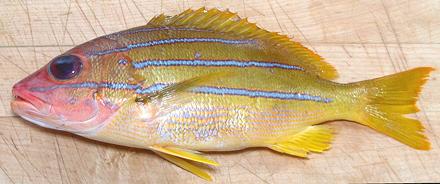 [Lutjanus kasmira]
[Lutjanus kasmira]
This true Snapper is native to the Indo-Pacific region, from the east coast of Africa to Hawaii. It can get up to nearly almost 16 inches long and 9 pounds, but is commonly around 10 inches. The photo specimen was 10 inches long and weighed 8-1/4 ounces. This snapper is a premium fish and fetches a premium price, but not as high as some other snappers. Bluestripe Snapper is not considered threatened, IUCN Red List rated NE (Not Evaluated).
More on Snapper Family.
Bluestripe Snapper, besides its striking color, has excellent flavor, but is not suitable for as wide a selection of cooking methods as some snappers, and yield is lower, so it's price is not as high as for some. The photo specimen was purchased at a Philippine market in Los Angeles for 2014 US $5.99 per pound.
The flesh is white with medium taste and good flavor. It is fine for fish lovers, but will not deeply offend those who like their fish bland.
Cooking: This is a fine fish for skinless fillets, but skin shrink is too severe for any method of cooking where the skin is left on. The flesh stays quite firm with wet cooking, so it is useful for soups and stews.
Scales: The scales are medium size with moderate adhesion, so they scrape off fairly easily with moderate flying about, but some will capsize rather than come loose and will have to be picked off by hand.
Cleaning: This fish presents no particular problems in cleaning. The gills pull a little hard, so use long nose pliers.
Fillet: This is a fairly easy fish to fillet with easy to follow bone structure. There should be almost no flesh left behind. I usually remove the head before filleting. Tilt the knife to get under the gill covers to get as much flesh as possible. There will be a couple small bones you'll need to cut with kitchen shears, and then the backbone.
When I get to the rib cage I just cut the ribs away from the backbone with kitchen shears and pull them from the fillet using long nose pliers. They pull easily and cleanly. There are a substantial centerline spines which need to be pulled extending from the front cut to the end of the body cavity.
Skin: The skin has no strong or "off" flavor, but shrink is extreme, and it does not let loose during cooking. Since the skin is so tough, fillets can be skinned rather easily using the long knife and cutting board Method, and they can be included with heads, bones and fins for making stock.
Yield: An 8-3/4 ounce fish yielded 3-3/4 ounces of skin-on fillet (43%), and 3-1/4 ounces skinless (37%). Yield would be somewhat better with a larger fish.
Stock: The head, bones and fins make a very fine nearly clear soup stock - and you can even toss in the skins for better yield. There is moderate oil, which should be removed - use your gravy separator. For details see our Fish Stock page.
sf_snapbsz 141102 - www.clovegarden.com